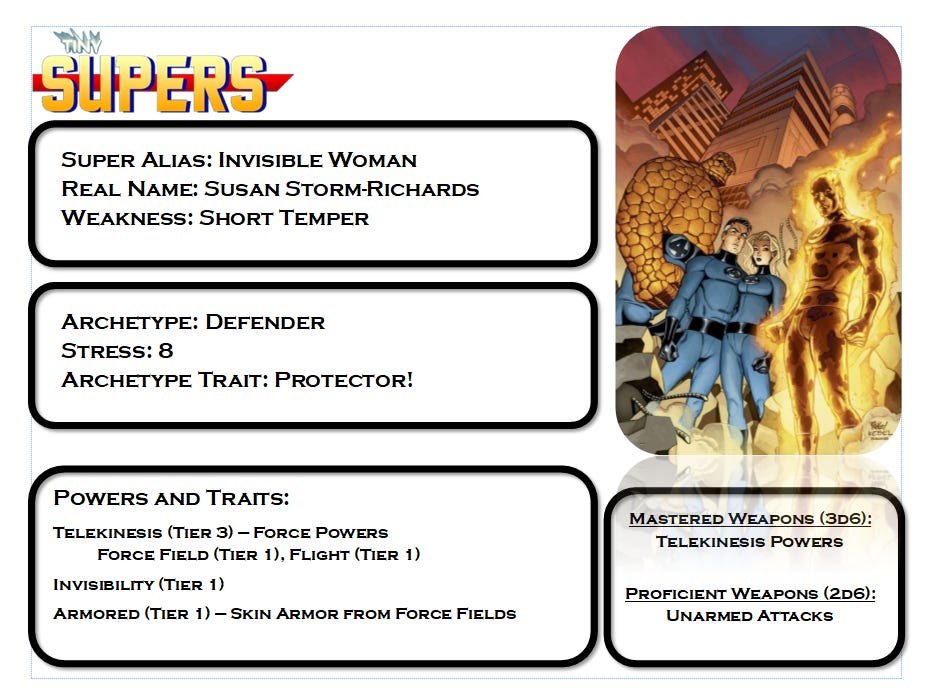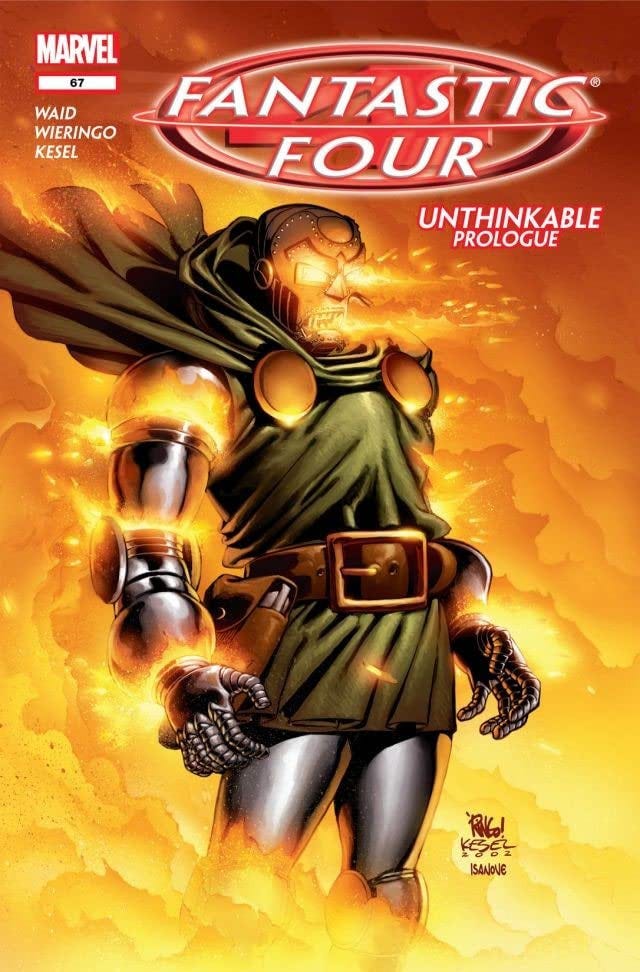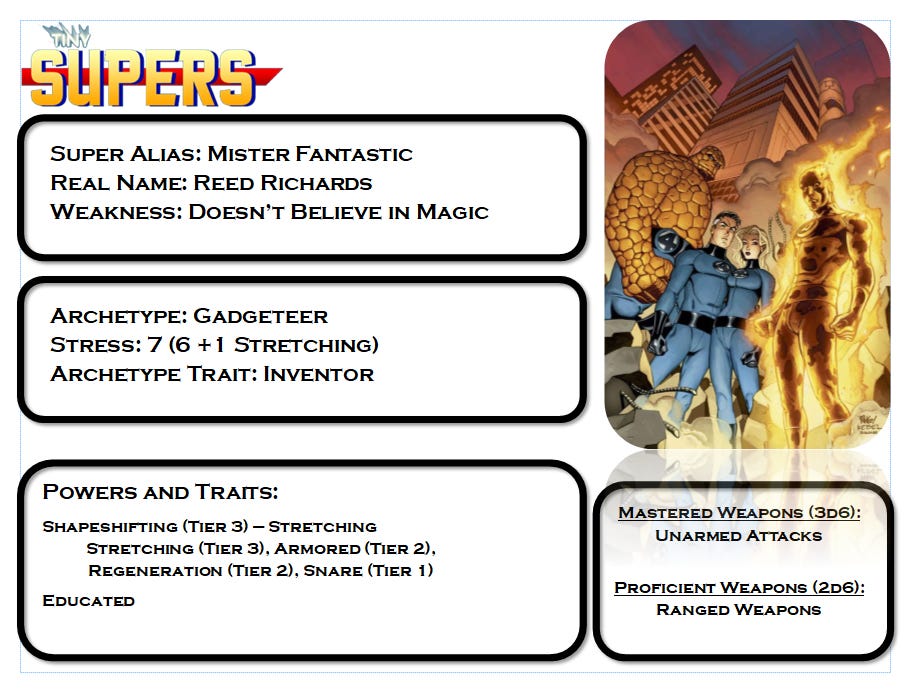Tiny Supers and Marvel's First Family
Emulating the Fantastic Four in Tiny Supers
I am a HUGE fan of superhero role playing games. Like most gamers, my first role playing experience was a session of Dungeons & Dragons, but as I’ve mentioned before that didn’t go very well. It was such a bad session that it really is kind of a miracle that I ever decided to play D&D a second time. It was only because of my close friendship with Sean McPhail, and the amazing time I had with our Dungeons & Boarding Parties sessions, that I came to see just how fun role playing games could be.
My First D&D Experience was Terrible
There’s a common aphorism I see turn up from time to time in conversations in the online role playing game community, “any role playing game is good as long as you have a good Game Master/Good Group.…
Though the Dungeons & Boarding Parties battles gave me a love of the hobby, my early attempts at being a Dungeon Master were pretty terrible. As much as I loved playing “The Great Siege of Castellan Keep and Sacking of the Caves of Chaos”, between those sessions, and my forays into running the Monster Manual as an adventure, I was off to a terrible start as a Game Master. It was only when I discovered superhero role playing games that I began to see the true potential of role playing as a means of entertainment. I could be more than dungeon crawls and hack and slash activities. Role playing sessions could feature narrative elements, and humor, and might not even feature a fight. Those words would have shocked me as a hack and slash gamer, but the more I became true “fantasy” gamer the more fun I had with the hobby.
I’ll go into detail in an upcoming newsletter about how I discovered superhero role playing games (thanks Christian Hunt) and how the Champions and DC Heroes games I ran in college changed my life, but today I wanted to share a little love for a “tiny” game for which I have a tremendous amount of passion. That game is Alan Bahr’s Tiny Supers and I think that it is one of the best superhero games ever designed. I’ll be doing a full review of the Tiny Supers system later this year, but with the upcoming release of the Fantastic Four movie, I thought that this would be a perfect time to see how easily the game emulates Marvel’s First Family.
While the Fantastic Four has never quite been able to translate successfully to the big screen, they are among Marvel Comics' most iconic characters. The Fantastic Four are particular favorites of mine, so I jumped at the chance to convert them to the Tiny Supers role playing game system as a way to test it out. It's a pretty good fit, but maybe your take would be a little bit different. Feel free to give us your ideas for how you would adapt these or other characters to this quick and easy to play super hero role playing game. Is Johnny a "Striker"? Is Susan Richards best defined as a "Defender"? Would you use a different mix of powers?
There are a couple of caveats to these character interpretations. First, I am only using the core Tiny Supers rule book and none of the supplements. The powers of the characters would look slightly different if I used those because Alan expanded on some ideas in ways that even better capture the feel of the Four. Second, any interpretation is exactly that. These are not set in stone. They are merely quick and dirty interpretations of the characters designed to allow for players to hop right in and play.
The Human Torch
As mixed as the various Fantastic Four films have been narratively and cinematographically, there is one character that has been a highlight of every production. Whether it’s the bargain basement Roger Corman film or the odd interpretation provided in Josh Trank’s 2015 version of the film, Johnny Storm has made the experience worth the price of admission. Jay Underwood, Chris Evans, and Michael B. Jordan all captured the joy, humor, and pathos of the character, even as their films failed to capture the magic of the First Family. Because of that, and because he’s long been my favorite member of the team, I am presenting Johnny Storm first.
The write-up is very simple. In Tiny Supers, you pick an archetype for each character that gives a related trait that is unique to that archetype. Almost all of the archetypes allow you to purchase superpowers later on, with one exception that we don’t need to discuss because there are no Dark Knight Detectives in the Classic Foursome. In this case I chose “Striker” because that trait allows for a character do do more damage in general and Johnny, with his ability to focus and “nova” is an always relevant combatant, even against Cosmic foes.
The powers were easy to pick with Elemental Control (Fire) doing the lion’s share of the labor. It gives him a ranged attack, flight, and increased damage. I added armored and immunity to heat to round him out as a character. If I was using one of the expansions, I’d give him a damage shield so that when normal people punch him they’d “feel the burn,” but this is a well rounded and easy to play character.
The Invisible Woman
Last year, I published a conversion of Sue Storm-Richards for the Villains & Vigilantes game. I think it’s an excellent conversion, but it also highlighted some of the weaknesses of the V&V game system and how it requires some mental flexibility to adapt abilities that are underpowered mechanically.
Simulation vs. Playability in Villains & Vigilantes 2e: A Look at Telekinesis and Force Field
The Weekly Geekly Rundown will come out this weekend, but here’s some geeky analysis to tide you over.
Tiny Supers doesn’t have the same issue that V&V did when it comes to Sue’s power set. That’s largely because it doesn’t quantify things at a granular level in the same ways as that other system. Villains & Vigilantes goes out of its way to let you know just how much weight a character can lift where Tiny Supers has much broader categories (Tier 1, 2, or 3).
With Susan’s conversion, I went with the Defender archetype because she often puts herself or her invisible shields in the way of foes attacks. Given that she’s a natural leader in combat, much more so than the often overconfident Reed, I could have picked Mastermind which lets her make her teammates more effective. I think either fit, but Defender makes her more resilient. Once again, a Power Set is doing the majority of the work here. In this case it’s the Telekinesis power modified to represent her Force Powers. The upcoming Ion Guard setting book has a Force Power Framework, but even then this particular vision captures her powers better. She might be best emulated with both the Telekinesis Power Set and Force Field separately, since this version doesn’t technically allow her to build a larger force bubble the Protector! ability simulates that by letting her have any damage directed at her. Given Tiny Supers narrative philosophy, that is but GM handwave away. You’d have to make some slight changes to make the Angry Byrne Era Sue, but that’s easy enough done.
Mister Fantastic
The team’s founder himself and the lynchpin around which most of the Fantastic Four’s conflicts revolve. Whether it’s Annihilus or Doctor Doom, you can bet they are pissed at the Four because of something Reed did. In the case of Annihilus, that’s just opening a portal to his dimension, but in the case of Doom I kind of think Victor’s got a point about Reed being the real villain. The version I’ve adapted here is heavily influenced by the Unthinkable storyline where Reed becomes incapacitated when facing Doom using magical powers because his rational mind cannot comprehend fully what Doom is doing.
I selected the Gadgeteer archetype for Reed because he should have the ability to build new devices during game sessions to defeat the foes of the Four. After all, that’s how he canonically defeated Galactus. The Shapeshifting power in Tiny Supers is very flexible and makes Reed a worthy combatant. Sure, he’d have a hard time hurting a foe with Super Strength and Armor, but that’s true in the books as well. One of the great things about Tiny Supers is that the combat system is narrative enough that even lower powered characters matter in combat, just as they do in the comics. If I was using an expansion, I’d give him the Genius Level Intellect Power at Tier 3 but that’s not necessary here.
The Thing
Last, but certainly not least, comes the Ever Lovin’ Blue Eyed Thing. Ben Grimm is a very straightforward Super Strong and Super Tough character who can go mano a mano against all of Marvel’s Heavyweights, even as he’s slightly less strong. To represent this, I gave him Tier 2 Super Strength though you could give him Tier 3 if you wanted. I figured that Tier 3 would be reserved for The Hulk, Thor, and other character on the top of the Strength spectrum. He’s super strong regardless and as I’ve said before, Tiny Supers is a narrative system. Having Super Strength at all makes him unbelievably strong. It’s up to you and the Game Master to determine what that means in play.
Like Sue, he’s a Defender which seems to match the fact that while he’s super strong, the real reason he can fight The Hulk is that he’s extremely hard to hurt. I’ve given him some additional traits to reflect the fact that he can take a licking and keep on ticking.
Conclusion
So that’s my brief rundown of the Fantastic Four, as a teaser to an upcoming review of the Tiny Supers game. What do you think? What would you do differently? Are there any characters you’d like to see me adapt as a part of the upcoming review?










Not having read the rules, I don’t know how well Tiny Supers would adapt the Richards & Grimm kids (all 4 of them) but curious to see. May have to pick up Tiny Supers myself and try a game as I too am a supers RPG collector & afficianado